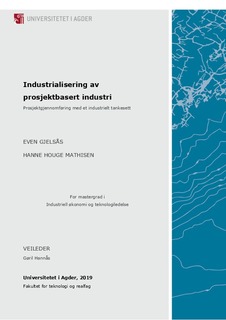| dc.description.abstract | One third of all economic activity in Norway is carried out in projects, and the proportion of project work is increasing in all parts of society. Projects occurin all sectors, including construction. The construction industry is characterized by low efficiency compared to the manufacturingindustry. Industrialization is proposed as a possible measure to increase efficiency. However, the project-based industry lacks a common understanding of the meaning of industrialization in the industry and current literature on project management fails to address it. Thisthesis aims to build a framework to understand industrialization in projects. To do so, industrialization and central characteristics of projects are examined. Research has been carried out using qualitative case studies of two large Norwegian companies within the construction industry and a literature review. The findings indicate that the uniqueness ofelements inprojects can be reduced,due to similarities in workflows. This means that projects can utilize an industrial mindset by focusing on the three dimensions organization, standardization, and technology. In order to ensure industrialization in the projects, it is important that this is facilitated for in the choice of project delivery model. Within the organizational dimension, an industrial mindset is largelyabout utilizing the expertise that exists in the project and facilitating for cooperation. This can be done through early involvement and joint contracts. Strategies must also be put in place to exploit industrialization to the fullest. The standardization dimension includes both processes and products. Despite projects' uniqueness, individual products and processes can be standardized. By having standardized requirements, decision gates and workflows, positiveeffects can occur. The technology dimension is not necessarily about increased use, butsmart use of solutions that can make the projects more efficient and improve collaboration. By utilizing benefits from economy of scale, and by moving the value chain towards Make-to-Order, the projects can extract the positive effects of industrialization.The effects of industrialization can be a reduction of costs through benefits of economy of scale and reuse of solutions. Improved quality can be achieved through similar processes across projects and the use of technology to automatically discover errors.Collaboration between the project's stakeholders can optimize the lead time and increase the reliability of estimates. Standardization can be positive for HSE but have a negative effect on flexibility. However, technology may improve flexibility and maintain the level of standardization. In order to ensure project success
Vand take advantage of industrialization, it is important that the industrial mindset is implemented throughout the value chain and in all phases of the project. Sharing of experience and knowledge can create improvement, and to increase customer value processes, the flow between tasks has to be considered. A production strategy that facilitates for industrialization should be chosen to improve project delivery. | nb_NO |

